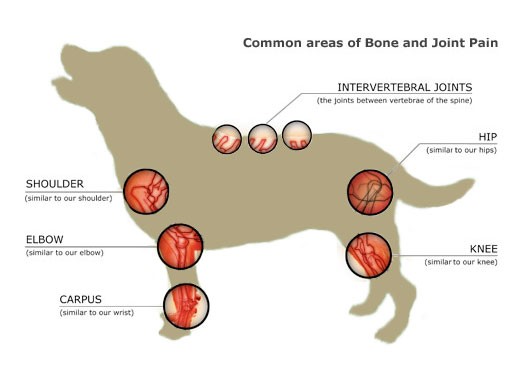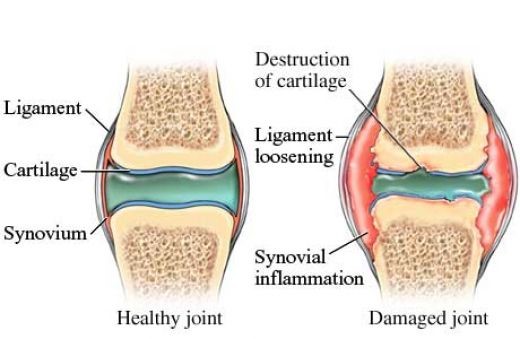Main Index
In Store
Our Web Store
Miniature Schnauzer Picture Gallery
Latest Dog Blogs
- What Are The Basic Commands To Train A Dog?
- PaySafe As The Most Popular Type Of Deposit
- Everything You Need To Know About Pet Sales
- Dogs Contribute To Our Physical And Mental Well Being
- How To Choose Where To Bet On Greyhounds In 2022
- Volunteer With Animals - How To Help Dogs Around The World
- Basic Understanding Of The House Edge
- Why You Should Get A Dog
- Top 20 Popular Dog Names Around The World
- Constipation in Dogs and How to Find Solutions
Canine Osteoarthritis: Signs, Cause and Diagnosis
- 24/03/2015
Canine osteoarthritis or arthritis is a chronic degenerative disease that is common mainly in middle-aged to older dogs. Even younger dogs can suffer from this problem. This problem is more common in dogs than in cats. In fact, 65% of the dogs which are over six years old show some signs of osteoarthritis. So if you own a canine companion, you will probably have to deal with this disease some day.
This debilitating and painful disease can adversely affect your furry friend's lifestyle, comfort, and emotional wellbeing. This ailment can affect any joint in the dog’s body, but the most commonly affected joints include:
- Elbow
- Hips
- Stifle (knee joint)
- Shoulder
- Carpus (wrist)
- Hock (ankle)
- Intervertebral joints (backbone)
Warning Signs of Arthritis in Dogs:
Dogs suffering from osteoarthritis can experience discomfort and pain that result from damage within the above mentioned joint. The below mentioned 10 signs can be symptoms of canine arthritis. Make sure to check with your vet if your canine companion is displaying any of these symptoms:
- Reluctance to climb stairs or difficulty jumping up
- Difficulty or hesitation to get up or sit down
- Stiffness in the morning that improves as the day progresses
- Lameness in one or more limbs
- Subtle signs that the pet may not want to put weight on the limb
- Sensitivity when touched in certain areas
- Abnormal behaviors in dog such as withdrawal, irritability or aggression
- Licking or chewing at the painful joint
- Reluctance to rise or difficulty rising
- Pain when handled
Causes of Arthritis in Dogs
The joint bones of canines are covered with the smooth cartilage that makes the movement of the joints easier, as it avoids the friction of the joint bones against each other. If this smooth cartilage of joint gets damaged, the joint tissue becomes irritated and it starts releasing harmful substances that cause additional damage.
The damage of joint cartilage is not painful in itself, as only the joint ligaments, capsules and supportive tissues have nerve cells. Therefore, dogs will not feel pain until the condition is quite advanced. The common causes of this ailment include:
- Malformation of the bones is congenital and it can cause the joints to damage the cartilage
- Trauma or infection of joints
- Aging
- Autoimmune diseases
- Tearing of joints or ligaments
- Poor diet
- The puppy's being overweight during growth
Some other causes of canine osteoarthritis are:
- Trauma: Traumatic injury can also be the cause of joint disease. The injuries in car accidents (being hit by a car), falling from a high place, and bite wounds etc. can lead to the osteoarthritis in dogs.
- Infection: The infection of joint can be caused by previous surgery or bite wounds, but joint infections are rare in the dogs. However, if it happens it should be treated immediately.
- Cancer: Joint pain and osteoarthritis can be the first signs of cancer, such as cancer of the joint capsule and cancer of the surrounding bone. Fortunately, the joint cancer is rare in the dogs.
Canine osteoarthritis can manifest itself in below mentioned ways:
1. Hip Dysplasia: It is a poor development of dog’s hip joint. The hip joint is composed of the socket and the ball. In hip dysplasia, dogs can develop a shallow hip socket and the ball on their thigh bone is flattened. It causes excessive movement in the joint, causing calcium deposition and chronic inflammation.
2. Knee-cap dislocation: Also known as Patella Luxation, this disease is one of the most common problems with small breed dogs like the Pomeranians and Chihuahua. It is a hereditary problem and caused by a malformation of the leg bones.
In this condition, the kneecap is being repeatedly pulled out of position. The pet will show signs of this medical condition only when their knee cap is sliding out of the place. After knee-cap dislocation, dogs can be seen limping or running with the affected leg held off the ground. Your dog will often stretch the affected leg out behind him in an effort to click the cartilage back into its place.
3. Shoulder Joint Degeneration: It is commonly seen in the medium to large dog breeds, and caused by a breakdown of the cartilage in the shoulder. This disease results in joint pain and inflammation.
4. Septic Arthritis: It is an infection of the joint space and can occur after an injury, or if bacteria spreads through the blood and lodges in a joint. In this medical condition, permanent damage can also occur if not treated in the early stage.
Diagnoses of Canine osteoarthritis
The most common means of diagnosing osteoarthritis in dogs is a physical examination coupled with radiographs (x-rays) which demonstrate changes within the joint. An analysis of joint fluid may be recommended in some cases to rule out the immune-mediated or infectious disease. Other tests such as CT or MRI scans and bone scanning may also be required for a definitive diagnosis of this disease. Canine osteoarthritis is incurable, but proper and timely treatment can greatly improve the quality of life of your canine companion.
Please Help Us
IrishDogs.ie takes a lot of time, money and hard work to produce. But we do it because we believe our perspective matters because it might well be your perspective, too.
Our future could be much more secure with your help. Please SUPPORT us by clicking on the Donate Button at the Top Right of your screen.
Quick Search
Donate
Latest Dog Pods
- Tips on How to Stop Your Dog from Biting
- Beware - Not All Advertised Dog Rescues Really Are! How Can You Know The Truth?
- Helpful Tips For Dog Obedience Problems
- How to Keep Dogs From Eating Poop
- Dog Grooming Tips - A General Overview of the Very Basics of Dog Grooming
- Recognising Different Types of Dog Obedience Problems
- 5 Important Tips On Feeding A Puppy




